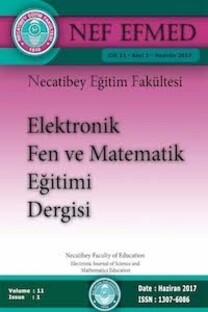Okul Öncesi Öğretmen Adaylarının Bilimsel Kavramların İçselleştirmesinde Grafikleri Zihin Aracı Olarak Kullanmaları
okul öncesi öğretmen adayları, fen eğitimi dersi, sosyo-kültürel kuram, zihin araçları, astronomi
Preservice Early Childhood Teachers Use of Graphs as Mental Tools in Internalizing Scientific Concepts
preservice early childhood teachers, science methods course, socio-cultural theory, mental tools, astronomy,
___
- Bogdan, R. C., & Biklen, S. K. (1982). Qualitative research for education: An introduction to theory and methods. Allyn and Bacon MA:Boston.
- Driver, R., Asoko, H., Leach, J., Scott, P., & Mortimer, E. (1994). Constructing scientific knowledge in the classroom. Educational Researcher, 23(7), 5-12.
- Glesne, C., & Peshkin, A. (1992). Becoming qualitative researchers: An introduction. New York: Longman.
- Hewson, P., W. (2004). Resources for science learning: Tools, tasks, and environment. International Journal of Science and Mathematics Education, 2, 201-225.
- Hobson, S. M., Trundle, K. C., & Saçkes, M. (2010). Using a planetarium software program to promote conceptual change with young children. Journal of Science Education and Technology, 19(2), 165-176.
- Jones, M. G., Rua, M. J., & Carter, G. (1998). Science teachers’ conceptual growth within Vygotsky’s zone of proximal development. Journal of Research in Science Teaching, 35(9), 967-985.
- Kallery, M., & Psillos, D. (2001). Preschool teachers’ content knowledge in science: Their understanding of elementary science concepts and of issues raised by children’s questions. International Journals of Early Years Education, 9(3), 165-179.
- Lemke, J., L. (2001). Articulating communities: Sociocultural perspectives on science education. Journal of Research in Science Teaching, 38(3), 296-316.
- Mercer, N., Dawes, L., Wegerif, R., & Sams, C. (2004). Reasoning as a scientist: Ways of helping children to use language to learn science. British Educational Research Journal, 30(3), 359-377.
- Macbeth, D. (2000). On an actual apparatus for conceptual change. Science Education, 84(2), 228-264.
- Osborne, J., Simon, S., & Collins, S. (2003). Attitudes towards science: a review of the literature and its implications. International Journal of Science Education, 25(9), 1049-1079.
- Renshaw, P., & Brown, R. A. J. (2007). Formats of classroom talk for integrating everyday and scientific discourse: Replacement, interweaving, contextual privileging and pastiche. Language and Education, 21(6), 531-549.
- Roald, I., & Mikalsen, O. (2001) Configuration and dynamics of the Earth-Sun-Moon system: An investigation into conceptions of deaf and hearing pupils. International Journal of Science Education, 23, 423-440.
- Rogoff, B. (2003). The cultural nature of human development. New York: Oxford Univeristy Press.
- Roth, W., & Bowen, G. M. (1999). Of cannibals, missionaries, and coverts: Graphing competencies from grade 8 to professional science inside (classrooms) and outside (field/laboratory). Science, Technology, & Human Values, 24(2), 179-212.
- Schoultz, J., Saljo, R., & Wyndhamn, J. (2001). Heavenly talk: Discourse, artifacts, and children’s understanding of elementary astronomy. Human Development, 44, 103-118.
- Trundle, K. C., Saçkes, M., Smith, M. M., & Miller, H. L. (2012, September). Preschoolers’ ideas about day and night and objects in the sky. Paper presented at the annual meeting of the International Congress on Early Childhood Education. Adana, Turkey, September 12-15.
- Wells, G., & Claxton, G. (2002). Introduction: Sociocultural perspective on the future of education. In G. Wells & G. Claxton (Eds.). Learning or life in the 21st century (pp.1-18). Oxford, UK: Blackwell Publishers.
- Vygotsky, L. V. (1978). Mind in society: The development of higher psychologicalprocess. (edited by, M. Cole, V. John-Steiner, S. Scribner, E. Souberman).Massachusetts: Harvard University Press.
- Za’rour, G. I. (1976). Interpretation of natural phenomena by Lebanese school children. Science Education, 60(2), 277-287.
- ISSN: 1307-6086
- Yayın Aralığı: 2
- Başlangıç: 2007
- Yayıncı: Balıkesir Üniv. Necatibey Eğitim Fak.
İlkokul 3. Sınıf Öğrencilerinin Mikroskop Üzerine Düşüncelerinin İncelenmesi
Merve ERDEM, FEHİME SEVİL YALÇIN, SİBEL TELLİ
Ortaokul Öğrencileri İçin Matematik Sınavı Kaygısı Ölçeği: Bir Ölçek Geliştirme Çalışması
The Effects Of Reflective Thinking Activities On Science Process Skills
Recep DURU, Nesra DURU, HİKMET SÜRMELİ
EMRE YILDIZ, ÜMİT ŞİMŞEK, Hakan ARAS
Şule SARIBAŞ, Yaşare AKTAŞ ARNAS
Analojilerin Fen Eğitimindeki Yeri ve Önemi
Ali Yiğit KUTLUCA, ABDULLAH AYDIN
Lise Öğrencileri İçin Basınç ve Kaldırma Kuvveti Konusuna Yönelik Tutum Ölçeği Geliştirilmesi
